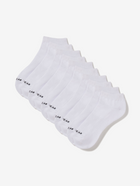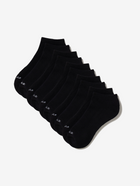It’s no secret that plastic waste is a growing problem. But did you know that athletic wear plays a role in plastic pollution?
Your typical athletic clothing brands can use high amounts of synthetic fabrics like polyester, nylon and spandex to create clothing.
To make these synthetic fabrics, you need oil. That means each purchase of workout leggings, pants, shirts, bras, and other fitness wear made of synthetic materials is actually contributing to climate change. The exception — purchasing second-hand clothing or buying apparel made from organic and recycled materials.
But that’s only the beginning of the problem with non-natural fabrics.
Plastic waste generally breaks down into small pieces, also known as microplastics. These tiny pieces of plastic are then released into our waterways and eventually end up in the ocean. Microfibers, which are shed from synthetic clothing, are the most prevalent type of microplastic.
When you wash synthetic athleticwear, these tiny microfibers make their way from your washer into waterways, eventually ending up in the ocean and everywhere on the planet. Because they are so small, microfibers are easily consumed by marine life such as fish, sea turtles, whales, dolphins, and manatees.
About 35% of all microplastics come from synthetic fibers. This means that every time you exercise or go for a run with synthetic clothing, you are releasing microscopic pieces of plastic into the environment and contaminating the world's water supply.
Microplastics are persistent, meaning they can remain in our oceans and other habitats for hundreds of years. There are millions of pieces of microplastic floating in our oceans right now; in fact, there are even traces of microplastics in every single ocean in the world.
Microplastics are a serious threat to marine life and the ecosystems where they live. When fish ingest microplastics, it can lower their fertility, reduce their ability to swim and evade predators, and damage their organs.
This is not just an environmental problem. It's a human health issue. Microplastics are consumed by other animals and can accumulate in the food we eat, ultimately ending up in our digestive systems.
Microplastics are also associated with persistent organic pollutants (POPs), toxic chemicals that can build up in our bloodstream over time and cause health problems in both humans and wildlife.
It’s a lot to take in. But we have hope for the future. Together, we can solve this problem, one sustainable choice at a time.
Here are some of the top actions you can take to combat plastic pollution from athletic clothing.
1) Shop Sustainably
Support activewear brands that are committed to reducing their use of plastic. Look for apparel made from natural, environmentally friendly materials.
2) Wash Smarter
How you wash your clothes matters. You can lessen the number of microfibers released from your laundry by 30 to 70 percent, all by changing how you do your laundry.
Follow these eco-friendly tips to help prevent tons of microfibers from being released into our waterways:
- Wash your clothes in cold water.
- Lessen the wash time by running the speed cycle.
- Run full wash loads.
- Switch from powder to eco-friendly liquid laundry detergent.
- Line dry your laundry or
- Use the delicate cycle to dry clothing.
- Invest in a high-efficiency washing machine when it’s time for an appliance upgrade.
3) Filter Out Microfibers
The steps mentioned above can really help. But there are still going to be some microplastics escaping into the ocean.
Nowadays, there are filters designed specifically to catch microfibers before they leave your home. Planet Care offers a closed-loop solution to make sure your microfibers never enter the ocean.
There's no doubt that every little bit helps when it comes to fighting pollution. That’s why it’s so important to reduce your consumption of plastics in every area of your life — including your training routine.
The best thing you can do is prevent more plastic from entering the world in the first place. Purchasing performance apparel made from natural, renewable materials like organic cotton and our other innovative blends is one of the biggest ways you can help solve this problem.
Allwear’s performance apparel is designed to be sustainable. Our apparel is made from natural, eco-friendly materials, so you can put your mind at ease knowing that your workout is putting less stress on the planet.
The hard truth is that microplastic is a real problem, and one of the main causes is fast fashion. We are determined to be part of the solution in transforming the apparel industry for the better.
Next time you need new athletic apparel, be sure to check what it’s made from. Together, we will create a world where we protect our ecosystems — and our health — from microplastics.



